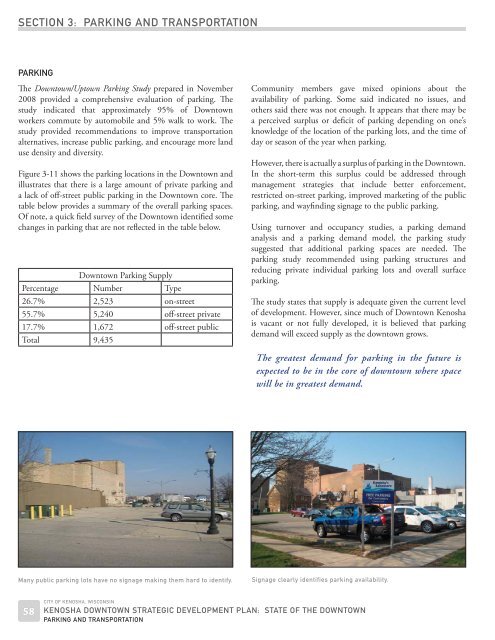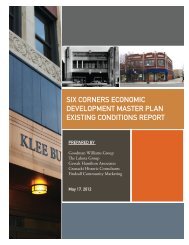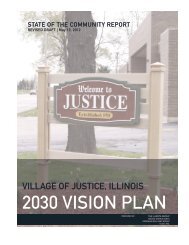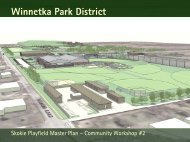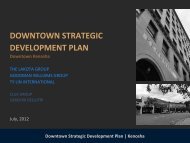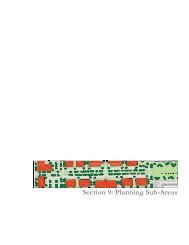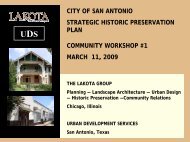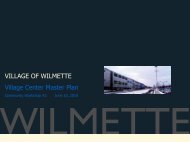Kenosha State of Downtown Report.indd - The Lakota Group
Kenosha State of Downtown Report.indd - The Lakota Group
Kenosha State of Downtown Report.indd - The Lakota Group
Create successful ePaper yourself
Turn your PDF publications into a flip-book with our unique Google optimized e-Paper software.
SECTION 3: PARKING AND TRANSPORTATION<br />
PARKING<br />
<strong>The</strong> <strong>Downtown</strong>/Uptown Parking Study prepared in November<br />
2008 provided a comprehensive evaluation <strong>of</strong> parking. <strong>The</strong><br />
study indicated that approximately 95% <strong>of</strong> <strong>Downtown</strong><br />
workers commute by automobile and 5% walk to work. <strong>The</strong><br />
study provided recommendations to improve transportation<br />
alternatives, increase public parking, and encourage more land<br />
use density and diversity.<br />
Figure 3-11 shows the parking locations in the <strong>Downtown</strong> and<br />
illustrates that there is a large amount <strong>of</strong> private parking and<br />
a lack <strong>of</strong> <strong>of</strong>f-street public parking in the <strong>Downtown</strong> core. <strong>The</strong><br />
table below provides a summary <strong>of</strong> the overall parking spaces.<br />
Of note, a quick field survey <strong>of</strong> the <strong>Downtown</strong> identified some<br />
changes in parking that are not reflected in the table below.<br />
<strong>Downtown</strong> Parking Supply<br />
Percentage Number Type<br />
26.7% 2,523 on-street<br />
55.7% 5,240 <strong>of</strong>f-street private<br />
17.7% 1,672 <strong>of</strong>f-street public<br />
Total 9,435<br />
Community members gave mixed opinions about the<br />
availability <strong>of</strong> parking. Some said indicated no issues, and<br />
others said there was not enough. It appears that there may be<br />
a perceived surplus or deficit <strong>of</strong> parking depending on one’s<br />
knowledge <strong>of</strong> the location <strong>of</strong> the parking lots, and the time <strong>of</strong><br />
day or season <strong>of</strong> the year when parking.<br />
However, there is actually a surplus <strong>of</strong> parking in the <strong>Downtown</strong>.<br />
In the short-term this surplus could be addressed through<br />
management strategies that include better enforcement,<br />
restricted on-street parking, improved marketing <strong>of</strong> the public<br />
parking, and wayfinding signage to the public parking.<br />
Using turnover and occupancy studies, a parking demand<br />
analysis and a parking demand model, the parking study<br />
suggested that additional parking spaces are needed. <strong>The</strong><br />
parking study recommended using parking structures and<br />
reducing private individual parking lots and overall surface<br />
parking.<br />
<strong>The</strong> study states that supply is adequate given the current level<br />
<strong>of</strong> development. However, since much <strong>of</strong> <strong>Downtown</strong> <strong>Kenosha</strong><br />
is vacant or not fully developed, it is believed that parking<br />
demand will exceed supply as the downtown grows.<br />
<strong>The</strong> greatest demand for parking in the future is<br />
expected to be in the core <strong>of</strong> downtown where space<br />
will be in greatest demand.<br />
Many public parking lots have no signage making them hard to identify.<br />
Signage clearly identifies parking availability.<br />
58<br />
CITY OF KENOSHA, WISCONSIN<br />
KENOSHA DOWNTOWN STRATEGIC DEVELOPMENT PLAN: STATE OF THE DOWNTOWN<br />
PARKING AND TRANSPORTATION


